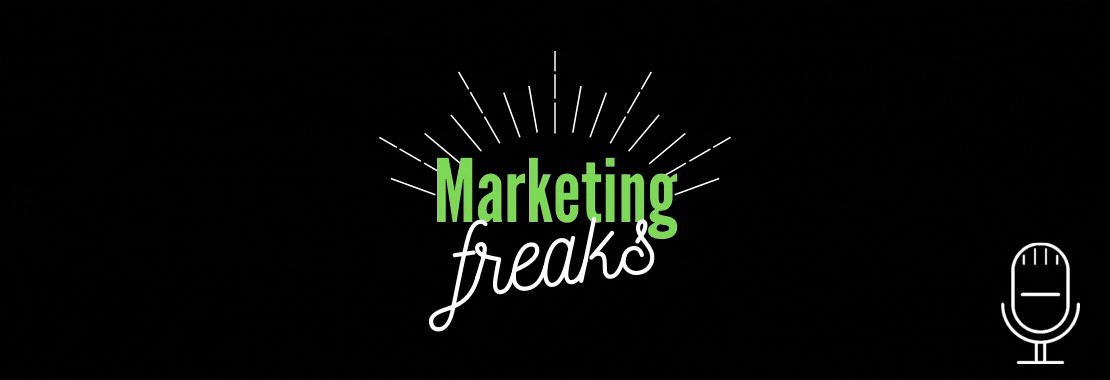Welcome back to the marketing freaks podcast! In this week’s episode, I’m joined by Halli from our Paid Social team to talk through the importance of having a good creative brief.
When it comes to running campaigns on social, creative is clearly a hugely important part of the mix. As such, if you’re working with external partners or other teams within the business, ensuring they know exactly what you need is imperative.
Subscribe links:
Throughout this episode we discuss how to improve your briefing process and some of the key things you need to consider. Ultimately this is about getting all the required information into a clear document, to make sure that the recipient is left in no doubt as to what is required. You can of course also take a look through the ads library for inspiration, but nothing will beat a well planned out brief.
We also talk through some of the pitfalls of NOT having a good brief. As with any other area of business, leaving gaps for interpretation often leads to mistakes. This then either causes delays and / or has a knock on effect on your performance. Obviously this is something to avoid.
Key to getting this process right is understanding your audience (AKA who is going to be working on the creative) and working closely with them to refine the briefing process. Not all teams will be the same, so having a degree of flexibility is always valuable.
Hope you find this episode useful!
Transcript:
Jon (00:10):
Hello everybody and welcome back to the Marketing Freaks podcast. In this week’s episode, I’m joined by Halle and we’re gonna be talking about the importance of having a detailed and clear creative brief to ensure you get the creative you need to get the most performance from your campaigns. Really hope you find this one useful. If you do come and subscribe. Spotify, apple Podcast, all your favorite podcast places, and let’s get started. Halle, it is wonderful to have you back on the podcast.
Halli (00:40):
Thank you for having me back
Jon (00:41):
Because the first episode we did was just after you started, it was about paid social for Noobs. Yep. Kind of as a noob. Yep.
Halli (00:49):
No longer am a year later. <laugh>.
Jon (00:51):
No, you’re obviously progressing very well and the um, that went down really well. So it’s lovely to have you back.
Halli (00:57):
Yeah, no, it’s great to be back. Finally off
Jon (00:58):
Your slightly unexpected
Halli (01:01):
Oh yeah, end to last year. Close, breaking my back. But we move eventually. We got there in the end, <laugh>
Jon (01:06):
Just like, wow.
Halli (01:08):
I know. It was, um, not expected, uh, obviously, but yeah, fell down the stairs. Um, literally the day I got back from holiday. So, uh, the day before I was parasailing, day after I was in a hospital, wed not ideal.
Jon (01:22):
It’s nuts how life throws curve balls, isn’t it?
Halli (01:26):
Oh, for sure. Um, wasn’t expecting that at the age I am, but yeah. Five steps later. <laugh>, here
Jon (01:32):
You are. This today is the first day you’ve been driving. I know. So it feels like a special day.
Halli (01:37):
It, it is momentous, honestly.
Jon (01:39):
And, and we’re having a barbecue. Oh,
Halli (01:41):
It’s just a good Friday to be honest, John. So
Jon (01:43):
What a brilliant day.
Halli (01:44):
Yeah. Looking forward to it.
Jon (01:46):
Back to the subject of this podcast, <laugh>. Um, so we’re gonna be talking about creative briefs now as a paid media agency who specialize in performance marketing. Why are we talking about creative briefs and why are they important within the context of what we do?
Halli (02:02):
Yeah, I think they’re, um, forgotten about a lot more than they should be. Uh, and they’re vital in terms of digital marketing, but in a variety of different creatives, uh, industries. Um, but it’s an outline essentially. It’s a document that outlines the goals, objectives, general requirements for a creative project. So it’s really important to have, um, essentially it’s like a blueprint I’d like to see it as mm-hmm. <affirmative>. So it is just something that should be put together to help guide the creative team in putting together what you need really.
Jon (02:33):
Definitely. And actually for context, you’ve in your previous life mm-hmm. <affirmative>, um, before you reincarnated as a paid social specialist <laugh> Yeah. You were on the receiving end of creative briefs cuz your job was video editing. Yeah,
Halli (02:47):
So production was in video editing for over five years within the industry. Um, so had a variety of creative briefs, but I know that they’re important simply because I was provided so many rubbish <laugh>. Um, and it just ended up in either us not putting together what they wanted simply because we didn’t have enough information or, um, yeah, not, not knowing what to do really and having to then go back and forth with the other end of the team to discuss what they actually wanted out of it.
Jon (03:15):
Yeah. I’m just gonna remove this contraband from this Fair enough shot.
Halli (03:19):
Fair.
Jon (03:19):
Yeah. The um, <laugh> ever, the professionals here. Why not? Um, yeah, so I guess as a, you are, I imagine you’re flying blind, aren’t you? So without the right information, you don’t know what’s needed, you don’t know what you need to produce and that introduces this massive risk that you are going to pass on something that the end customer or client doesn’t need or want.
Halli (03:44):
Yeah. Essentially there’s no
Jon (03:45):
Good for anyone.
Halli (03:46):
It could just be a complete waste of time and that’s what you want to avoid. Like time is money. Yep. And if you’re not doing it right the first time because of the lack of information, then there’s a serious issue.
Jon (03:56):
Definitely. So within performance marketing, yep. Nine times out of 10 when we are supplying people with a creative brief, it’s about ad creative, isn’t it? Yep. So we need a certain amount of ad creative to be able to do our job properly and to be able to drive the best performance for our clients. Yep. Normally with our clients, they have a creative team in house or a creative partner in place already. So our job is I guess much more of a, like an advisory role when it comes to creative currently anyway. Yeah. Um, so within that context, so if we’re talking about performance marketing campaigns, what should a good creative brief include? What does good look like?
Halli (04:37):
So as kind of like an overall, I think it’s great to start with one, like a brief introduction to the project. So what are we looking at, for example, in digital marketing terms, what do we want to test over the next quarter? Um, what have we seen work and now we want to further use it but in a different style. Um, also good to lay out the goals and objectives. So what are we looking to achieve? Um, details on the target audience. Yep. Obviously product dependent, um, copy variations, uh, CTA variations, what we looking at running, uh, what we looking for the personality and style of the creative. So are we testing something new? Is there a reason for that? What are we looking to achieve from that? Yep. Um, and most importantly a project timeline and budget. Um, I think if you don’t include this, you could risk waiting a long time for that creative.
Jon (05:28):
Yes. Yeah, definitely. It’s just, I guess it’s having everything nice and clear up front, isn’t it? Yeah. And if you can read back your creative brief and make sure there’s no room for interpretation Yep. That’s a good way of doing it. Yeah, for sure. Uh, I also assume things like formats are really key, aren’t they? And basic mechanical information if you like, like dimensions,
Halli (05:52):
Resolutions
Jon (05:53):
Ratios. Yeah. Um, which particularly if you are putting a creative brief in ahead of a shoot mm-hmm. <affirmative> for example, and you know that uh, in the next three months you’re gonna need to produce stories reels, um, one-to-one ratio images for Instagram. Yep. Maybe some landscape images for like a landing page, that type of stuff. So that’s quite a lot of different, you know, vertical landscape Yeah. Square, like there’s a lot within that. So, but if you can brief the photographer or the videographer that that’s the end goal, um, goal they can incorporate, incorporate that into the way they shoot footage or, or or do their bits. Yeah. So you’ve got more chance of getting the formats you want at the end. Yep,
Halli (06:42):
For sure. And it’s also important to include things if you are doing video content of like the length of the video, a lot of people aren’t aware of how long you should have it, make it too long, try and add too much in. Um, and obviously we try and guide them in the right direction of what you’re trying to achieve from this, this is what you need to include and how long for.
Jon (07:02):
Absolutely. Absolutely. Um, there’s also a point on considering your audience isn’t there. Yeah. Because, um, a creative brief going to a creative director mm-hmm. <affirmative> will be very different to a creative brief going to a photographer who’s doing a shoot Yeah. Or a designer who’s putting together some materials Yeah. Et cetera, et cetera, et cetera. So you like with any other documentation or, or work really, you have to consider who it’s going to and what they are gonna need to do with it.
Halli (07:34):
Yeah, for sure. And we, we have that with various clients we work with. Now all, all of their creative design team are completely different. It, it can be one person, it can be 10 people as you said. Um, but I think touching on what you’ve said previously, it’s just crucial to be clear in what you are writing. Yeah. Have enough detail in there that there essentially shouldn’t be any questions. Yep. Um, so yeah, that’s definitely what I’d try and achieve with the creative briefs that I put together.
Jon (08:00):
Yep. Brilliant. And then in terms of giving feedback on design or creative mm-hmm. <affirmative>, um,
Halli (08:07):
Touchy subject <laugh>.
Jon (08:08):
Yeah. But it’s really difficult when you’re not a designer Yeah. Or a photographer or whatever, whatever. It’s really difficult to give constructive feedback. Mm-hmm. <affirmative> and I, I know we’re talking about briefs here, but it’s almost about communication with other teams and disciplines. Right. So have you got any tips on that? Because it’s hard to say, oh, I just want it to look a bit more funky. Yeah,
Halli (08:38):
It’s um,
Jon (08:39):
It’s,
Halli (08:40):
It’s a tricky one cuz I think there, as you said, there’s such a fine line, but it’s, it’s not about that you’re trying to slate their work as such. No, you are, you are telling them, look, you’re great at what you do and I appreciate that you are the designer here, but what we are looking for is to include this bit of copy on the static image or in the first three seconds can we have it saying this? Yeah. Um, or if it’s an influencer, can we have them including this, this, and this. It’s, it’s more giving pointers as opposed to telling them what to do.
Jon (09:11):
I’m trying to be as tangible as possible. Right. Yeah, for sure. Specific.
Halli (09:15):
Yeah, exactly that. So it’s, yeah, I I’d like to say it’s more of a guidance as opposed to don’t do this, do this.
Jon (09:21):
Yeah. Cuz you can’t, when you’re hiring experts to do a job, you still want a degree of freedom for them. Yeah. An artistic license, don’t
Halli (09:28):
You? Yeah. And I touched on that later actually. Um, but yeah, no, it’s just one of those things that you want to be able to say, look, this is what we’ve seen work previously. Yeah. Cuz they also may not know that side of it. Yeah. If you’re seeing within the digital marketing industry that certain types of testimonials or something are working better, it’s just about giving that guidance of look, love what you’ve put together, but can we also test this?
Jon (09:50):
Yeah, definitely. I think examples are really good for that, aren’t they? So if you, if you’re struggling to, um, describe what you need Yeah. Having examples of creative that you like or examples of creative, um, that are in the, in the similar vein to what you’re trying to achieve mm-hmm. <affirmative>, that’s a really good way of communicating what it is you’re after.
Halli (10:15):
Yeah. And that’s something that we always do here. Um, so I always try to provide examples whether it’s something that they’ve done previously or someone else, uh, competitors currently using Yeah. That I think is worth testing just so they can kind of have a even clearer understanding of what I’m looking for. Yeah,
Jon (10:32):
Definitely. So what problems are we trying to avoid by putting together solid and thorough creative briefs?
Halli (10:41):
Yeah, I think there’s obviously a few, um, but one of the main ones that we’ve already touched on is just lack of clarity. Um, I think it just, it needs to in ensure, like, ensure that it is really clear and concise. Um, because the risk of having poor kind of clarity in it is either you don’t get content that you want, and again, we’re wasting time or the creative team just might go, I dunno what I’m doing, so I’m just not gonna do it. Yeah, yeah. And then you’ve achieved nothing. Yep. You’ve put together a creative brief that may have taken you a couple of hours that no one has acted on because they don’t get it. Yep. Yeah. Um, so yeah. Being being clear is 100% required. Yep. Um, I think also having missing information being too vague is an issue. Yeah. Um, so similar to the previous point, but it’s about not confusing them by being too in depth, but also having enough there that’s almost bullet pointed.
(11:36):
So it is like, right, these are the resolutions, these are the ratios, this is the copy we want, these are the CTAs, and then it, there, there is no confusion there at all. Yep. Um, but also I think as you mentioned, it’s just lack of creative freedom. What you don’t want to do is provide them with something that’s too rigid. You don’t wanna tell someone that’s a creative designer that they can’t use their head and Yeah. Their creative mind. Um, because then yeah. What, what if they’re not creating something that is engaging, that’s the risk that you’re gonna face. Yeah. And then no one, we can’t test anything that’s poor because that’s not all we wanna do. So it’s just, yeah. You gotta make sure you’re not counteracting yourself really.
Jon (12:17):
Yeah, definitely. That’s a fine balance, isn’t it? And again, it’s the more, you know, the people on the receiving end. Yeah. This, this is just the softer side of business, isn’t it? But if you, if you have a relationship with the person who’s receiving this, you’ll know what they’re like mm-hmm. <affirmative>, you’ll know what they’re good at, you’ll know what sort of steering
Halli (12:33):
They need. They
Jon (12:35):
Yeah. You know, all the rest of it. And again, that’s, that’s a big thing, isn’t it? Yeah, for
Halli (12:40):
Sure. I also think it’s important to kind of, if you have the opportunity, I know everyone doesn’t, um, but to kind of go through it face to face so it can be an open conversation. Yeah. Um, we’ve done that recently for a client who’s found it very helpful. Yep. Um, we put together quite a complex creative brief, had an hour discussion about it, had the creative team there so they can ask any questions. Then they could walk away from that meeting and go, yep, I know what I need to do, I know what they want from me. And then you are kind of cutting out all the back and forth emails as well.
Jon (13:09):
That’s a really good top tip actually. So it’s not just, don’t just send a PDF document and expect someone to read it in exactly the, the same way,
Halli (13:17):
Way Brit you
Jon (13:18):
Wanted it to be, because they will interpret it differently. Mm-hmm. <affirmative>. So having a call, like a delivery call to walk through it solves that problem.
Halli (13:27):
Absolutely. Couldn’t agree more.
Jon (13:29):
And for future briefs as well, because then everyone knows what page everyone else is on.
Halli (13:34):
Yeah. Couldn’t agree more.
Jon (13:35):
Very cool. Well, look, I think there’s loads of like nice little bits of advice within that and I’m sure it’s gonna help people get better, creative, more efficiently, avoid all the nasty little mistakes and situations that lack of clarity often gets you in. Yeah. Um, so yeah. Thank you Halle.
Halli (13:55):
Oh good. I think just one last point to give everyone that I think is very a bonus, helpful bonus, um, I always work by the three Cs, so being concise, being comprehensive, but also being collaborative.
Jon (14:09):
Very
Halli (14:09):
Nice. Something to take away.
Jon (14:11):
Very
Halli (14:11):
Go. You’re
Jon (14:11):
Welcome. Thank you Holly. That’s a brilliant bonus tip.
Halli (14:15):
No
Jon (14:15):
Worries. Thanks so much. And thanks to everyone for listening.
Halli (14:18):
Thanks for having me.
Jon (14:20):
Thank you so much for listening. If you enjoyed that episode, please do come and subscribe. Join us for future episodes where we talk about the ins and outs of running paid media and driving improved conversions of revenue for your business. See you next time.



